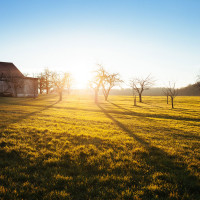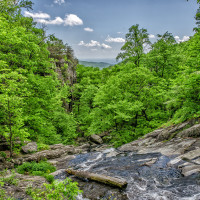Yosemite is one of the largest and least fragmented habitat blocks in the Sierra Nevada, and the park supports a diversity of plants and animals. The park has an elevation range from 2,127 to 13,114 feet (648 to 3,997 m) and contains five major vegetation zones: chaparral/oak woodland, lower montane forest, upper montane forest, subalpine zone, and alpine. Of California’s 7,000 plant species, about 50% occur in the Sierra Nevada and more than 20% within Yosemite. There is suitable habitat or documentation for more than 160 rare plants in the park, with rare local geologic formations and unique soils characterizing the restricted ranges many of these plants occupy.
Yosemite Directions
Yosemite National Park
The geology of the Yosemite area is characterized by granitic rocks and remnants of older rock. About 10 million years ago, the Sierra Nevada was uplifted and then tilted to form its relatively gentle western slopes and the more dramatic eastern slopes. The uplift increased the steepness of stream and river beds, resulting in formation of deep, narrow canyons. About 1 million years ago, snow and ice accumulated, forming glaciers at the higher alpine meadows that moved down the river valleys. Ice thickness in Yosemite Valley may have reached 4,000 feet (1,200 m) during the early glacial episode. The downslope movement of the ice masses cut and sculpted the U-shaped valley that attracts so many visitors to its scenic vistas today.
This video is a collaboration between Sheldon Neill and Colin Delehanty. All timelapses were shot on the Canon 5D Mark II with a variety of Canon L and Zeiss CP.2 Lenses. Thanks to Dynamic Perception for their motion controlled dolly and continued support!
Outdoor Activities in Yosemite
The administration of Yosemite National Park was transferred to the newly formed National Park Service in 1916, when W. B. Lewis was appointed as the park’s superintendent. Parsons Memorial Lodge and Tioga Pass Road, along with campgrounds at Tenaya and Merced lakes, were completed the same year; six hundred automobiles entered the east side of the park using Tioga Road that summer. The “All-Weather Highway” (now State Route 140) opened in 1926, ensuring year-long visitation and delivery of supplies under normal conditions. Completion of the 0.8-mile (1.3 km)-long Wawona Tunnel in 1933 significantly reduced travel time to Yosemite Valley from Wawona. The famous Tunnel View is on the valley side of the tunnel and Old Inspiration Point is above it. A flood, reduced lumber and mining extraction, and greatly increased automobile and bus use forced the Yosemite Valley Railway out of business in 1945. The present day Tioga Road, now part of California State Route 120, was dedicated in 1961.
Interpretive programs and services for national parks were pioneered in Yosemite by Harold C. Bryant and Loye Holmes Miller in 1920. Ansel F. Hall became the first park naturalist in 1921 and served in that role for two years. Hall’s idea to have park museums act as public contact centers for interpretive programs became a model followed by other national parks in the United States and internationally. Yosemite Museum, the first permanent museum in the National Park System, was completed in 1926.
The Ahwahnee Hotel, in Yosemite Valley, is a National Historic Landmark. Built in 1927, it is a luxury hotel designed by the architect Gilbert Stanley Underwood, decorated in Native American motifs. For many years it hosted an annual pageant produced by Ansel Adams. During World War II it was used as a rehabilitation hospital for soldiers.
This whole project has been an amazing experience. The two of us became friends through Vimeo and explored a shared interest in timelapsing Yosemite National Park over an extended period of time. We’d like to expand this idea to other locations and would appreciate any suggestions for a future project.
Our hearts go out to the families of Markus Praxmarer who lost his life while climbing Half Dome on September 19th, 2011 and Ranger Ryan Hiller, who was crushed by a tree January 22nd 2012. They will be missed. (A photo of Ranger Ryan Hiller can be found to the right, above the statistics counter)
GET NEWS!
Get news about our new themes, updates & things we’re working on…
Subscribe now!




















Add comment